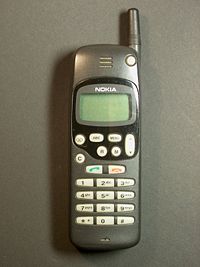
The Nokia 6230 is a mobile phone based on the Nokia Series 40 platform. It was announced on 28 October 2003 and released in February 2004.
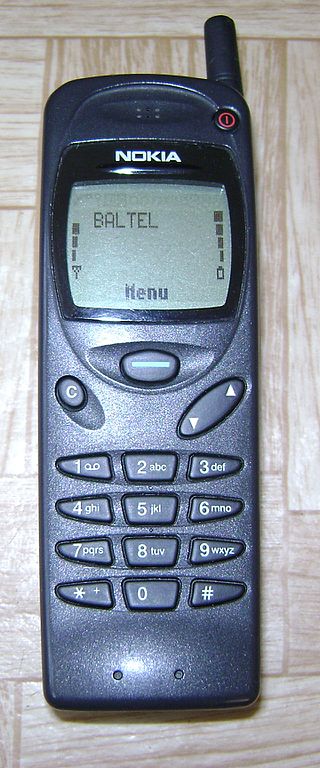
The 3110 is a GSM mobile phone handset manufactured by Nokia in Hungary, introduced at CEBIT in March 1997. The 3110 is notable as the first Nokia handset to feature the 'Navi-Key' menu navigation system. The Navi-Key was featured heavily on Nokia handsets, especially the entry-level models such as the Nokia 1100 in the following years. Unlike its successor, the 3210, and subsequent handsets of similar design, the 3110 had an external antenna. The phone was available with a slim, standard or vibrating battery. It could only be used on a GSM-900 network.
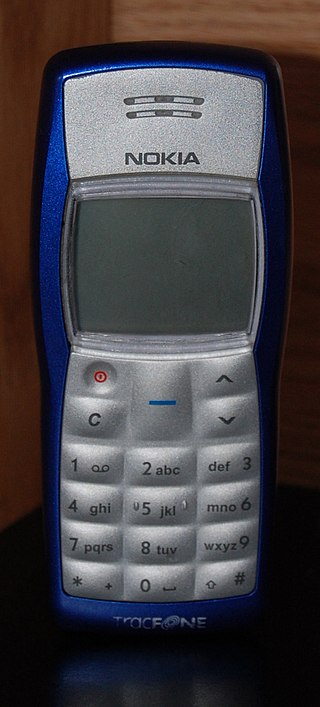
The Nokia 1100 is a basic GSM mobile phone produced by Nokia. Over 250 million 1100s have been sold since its launch in late 2003, making it the world's best selling phone handset and the best selling consumer electronics device in the world at the time. The model was announced on 27 August 2003 and was discontinued in September 2009.

A mobile phone feature is a capability, service, or application that a mobile phone offers to its users. Mobile phones are often referred to as feature phones, and offer basic telephony. Handsets with more advanced computing ability through the use of native code try to differentiate their own products by implementing additional functions to make them more attractive to consumers. This has led to great innovation in mobile phone development over the past 20 years.

Nokia 8210 is a mobile phone by Nokia, announced on 8 October 1999 in Paris. At the time, it was the smallest, lightest Nokia mobile phone on the market. A primary selling point of its design was its removable cover that allowed for easy customization. Six differently coloured Xpress-on covers are available, as well as many third-party ones.

The StarTAC is a series of mobile phones released by Motorola starting in 1996. It is the successor of the MicroTAC, a semi-clamshell design first launched in 1989. Whereas the MicroTAC's flip folded down from below the keypad, the StarTAC folded up from above the display. The StarTAC was among the first mobile phones to gain widespread consumer adoption; approximately 60 million StarTACs were sold.

The Nokia 8850 is a mobile phone handset manufactured by Nokia. It was a light alloy-bodied enhanced version of Nokia 8210 model with slider protection of the keypad and white lighting of the keypad and screen. The 8850 is considered to be an un-repairable phone, thus resulting in very few active handsets in the market. Today it remains a collector's item. It also came in gold. It was introduced as a successor of an earlier model, the chrome phone Nokia 8810.

The Nokia 6111 is a mid-level GSM mobile phone released in June 2005. It sold in Asia, Europe, Australia, Brazil and in Mexico, but was not taken by any carriers in the United States.
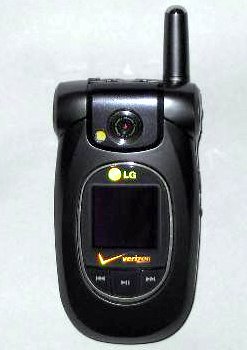
The LG LG VX8300 was one of Verizon's most popular mobile phones. This phone contains the following features:

The Nokia 6120 classic is a mid-range mobile phone from Nokia that was announced on 17 April 2007. It runs on Symbian v9.2 with a S60 3rd Edition FP1 user interface.

The Nokia 6310i is a mobile phone from Nokia first introduced at the CeBIT fair in March 2002 with sales starting later that year and discontinued in late 2005, it was Nokia's first tri-band phone offering. Primarily marketed as a business phone, it was for some years the dominant GSM device in the corporate world. The device was most commonly offered in Two-tone Silver/Grey or Two-tone Gold/Black trim; the third option, a Copper coloured variant, was much rarer.

The Motorola MicroTAC is a cellular phone first manufactured as an analog version in 1989. GSM-compatible and TDMA/Dual-Mode versions were introduced in 1994. The MicroTAC introduced a new "flip" design, where the "mouthpiece" folded over the keypad, although on later production the "mouthpiece" was actually located in the base of the phone, along with the ringer. This set the standard and became the model for modern flip phones today. Its predecessor was the much larger and heavier Motorola DynaTAC "brick" phone, and it was succeeded by the Motorola StarTAC in 1996. "TAC" was an abbreviation of "Total Area Coverage" in all three models.

Nokia 5300 XpressMusic is a slider mobile phone by Nokia, part of the XpressMusic range. It was introduced on 31 August 2006 and released at the end of that year. It runs on Nokia Series 40 3rd Edition FP2.

The Nokia 2110 is a cellular phone made by the Finnish telecommunications firm Nokia, first announced and released in January 1994. It is the first Nokia phone with the famous Nokia tune ringtone. The phone can send and receive SMS messages; and lists ten dialed calls, ten received calls and ten missed calls. At the time of the phone's release, it was smaller than others of its price and had a bigger display, so it became very popular. It also features a "revolutionary" new user interface featuring with two dynamic softkeys, which would later lead to the development of the Navi-key on its successor, the Nokia 6110, as well as the Series 20 interface.

The Nokia E71 is a mobile phone introduced on 8 May 2008 from the Eseries range with a QWERTY keyboard targeting business users worldwide. It runs on Symbian OS v9.2, with a Series 60 3rd Edition, second generation Feature Pack 1. The Nokia E71 succeeded the Nokia E61/61i models, building on the base design and form factor but enhancing on the feature set.

Nokia X3-00, is a multimedia-oriented mobile phone produced by Nokia. It comes with stereo-wide speakers, built-in FM radio with RDS, a standard 3.5 mm audio jack, media player and 3.2 megapixel camera. The phone runs under the Series 40 software platform. It was announced in September 2009 and later released in December 2009 worldwide.

The Nokia 6210 is a mobile phone made by Nokia. It was introduced at the CeBIT fair in Hanover in February 2000, succeeding the Nokia 6110. In addition to calling and SMS messaging, it has many other features, including an alarm clock, HSCSD modem, WAP web client, three games, calculator, to-do list application, calendar, infrared connectivity, voice recorder, and stopwatch. The plastic detail below the keypad, which Nokia called the Personal Badge, is removable; for a time, Nokia sent free promotional replacements, screen-printed with text of the customer's choosing.
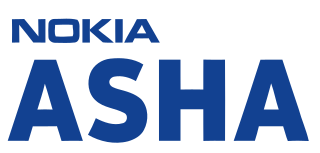
The Nokia Asha 303 is a QWERTY messenger smartphone powered by Nokia's Series 40 operating system. It was announced at Nokia World 2011 in London along with three others Asha phones - the Nokia Asha 200, 201 and 300. The 303 is considered to be the flagship of the Asha family. Its main features are the QWERTY keyboard and capacitive touchscreen, the pentaband 3G radio, SIP VoIP over 3G and Wi-Fi and the ability to play Angry Birds which were all never seen before on a Series 40 phone. Nokia Asha 303 is available in a number of languages depending on which territory it is marketed for. Models sold in South Asia support at least eight languages: English, Hindi, Gujarati, Marathi, Tamil, Kannada, Telugu and Malayalam.
The Nokia 8810 is a discontinued slider-style mobile phone announced and manufactured by Nokia in 1998. It is notable for being among the first mainstream mobile devices to have an internal antenna, although the first is regarded as the TCP-6000, released as the Hagenuk GlobalHandy.

The Nokia 2010 is a mobile phone that was announced by Finnish phone manufacturer Nokia in January 1994.
